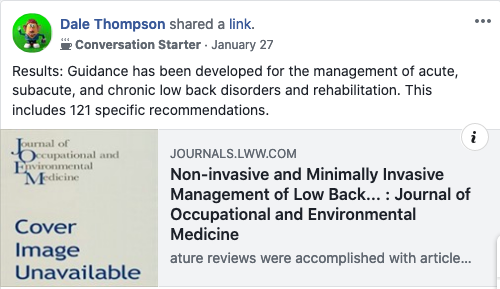Non-Invasive and Minimally Invasive Management of Low Back Disorders
Quality evidence to guide the treatment of LBP is available. Detailed algorithms have been developed using the quality evidence where available, with supplementation with the Panel's expert opinions (ie, consensus guidance). Acute LBP is best initially treated with directional stretching, progressive aerobic exercise, management of kinesiophobia, and NSAIDs. Work limitations may be needed especially for those with occupational demands exceeding the patient's abilities; limitations should be gradually eliminated. Adjunctive use of other treatments (eg, muscle relaxants, manipulation) may be added particularly for those with worse and/or persistent pain. There may be some patients for whom initial treatment with manipulation may be effective, however, if there is not rapid improvement with manipulation, it is recommended that the primary focus should change to progressive exercises. Other treatments with some evidence of efficacy include self-applied heat therapy. Failure of LBP to rapidly improve should necessitate an early search for, and treatment of other factors, including kinesiophobia and other psychosocial factors. Patients with radicular pain syndromes should be treated with maintaining activity as able, stretching, aerobic exercise, and NSAIDs. A course of oral glucocorticosteroids has some evidence of efficacy, although the Panel vote was split in large part based on the risk-benefit ratio driven by potential adverse effects. Ongoing or progressive neurological deficits require other treatment.
Patients with chronic LBP require institution of a program that primarily emphasizes functional restoration including aerobic exercise, strengthening exercises, and kinesiophobia. Cognitive behavioral therapy and functional restoration also have evidence of efficacy. Medications with evidence of efficacy include NSAIDs, norepinephrine reuptake inhibitor anti-depressants, and mixed SNRIs. Massage, manipulation, and acupuncture have some indications as adjunctive treatments; however, the emphasis should be on functional restoration. In no case should treatments be cumulative without ascertaining incremental functional benefits; instead, ineffective treatments should be discontinued after trialing.

#science #chiropractor #chiropractic #research #education #evidence based #patient centered #interprofessional #collaborative #rehabilitation #public health #spinal health #musculoskeletal health #ethics #pain #function #disability #QOL #knowledgetranslation


